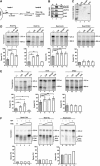RNA polymerase II bypass of oxidative DNA damage is regulated by transcription elongation factors
- PMID: 17110932
- PMCID: PMC1679758
- DOI: 10.1038/sj.emboj.7601403
RNA polymerase II bypass of oxidative DNA damage is regulated by transcription elongation factors
Abstract
Oxidative lesions represent the most abundant DNA lesions within the cell. In the present study, we investigated the impact of the oxidative lesions 8-oxoguanine, thymine glycol and 5-hydroxyuracil on RNA polymerase II (RNA pol II) transcription using a well-defined in vitro transcription system. We found that in a purified, reconstituted transcription system, these lesions block elongation by RNA pol II to different extents, depending on the type of lesion. Suggesting the presence of a bypass activity, the block to elongation is alleviated when transcription is carried out in HeLa cell nuclear extracts. By purifying this activity, we discovered that TFIIF could promote elongation through a thymine glycol lesion. The elongation factors Elongin and CSB, but not TFIIS, can also stimulate bypass of thymine glycol lesions, whereas Elongin, CSB and TFIIS can all enhance bypass of an 8-oxoguanine lesion. By increasing the efficiency with which RNA pol II reads through oxidative lesions, elongation factors can contribute to transcriptional mutagenesis, an activity that could have implications for the generation or progression of human diseases.
Figures




Similar articles
-
RNA polymerase II bypasses 8-oxoguanine in the presence of transcription elongation factor TFIIS.DNA Repair (Amst). 2007 Jun 1;6(6):841-51. doi: 10.1016/j.dnarep.2007.01.014. Epub 2007 Mar 19. DNA Repair (Amst). 2007. PMID: 17374514
-
Transcription activities at 8-oxoG lesions in DNA.DNA Repair (Amst). 2004 Nov 2;3(11):1457-68. doi: 10.1016/j.dnarep.2004.06.008. DNA Repair (Amst). 2004. PMID: 15380101
-
RNA interference against transcription elongation factor SII does not support its role in transcription-coupled nucleotide excision repair.Mutat Res. 2011 Jan 10;706(1-2):53-8. doi: 10.1016/j.mrfmmm.2010.10.010. Epub 2010 Nov 9. Mutat Res. 2011. PMID: 21070792
-
Transcription-coupled nucleotide excision repair in mammalian cells: molecular mechanisms and biological effects.Cell Res. 2008 Jan;18(1):73-84. doi: 10.1038/cr.2008.6. Cell Res. 2008. PMID: 18166977 Review.
-
When transcription and repair meet: a complex system.Trends Genet. 2006 Aug;22(8):430-6. doi: 10.1016/j.tig.2006.06.006. Epub 2006 Jun 23. Trends Genet. 2006. PMID: 16797777 Review.
Cited by
-
Cockayne syndrome B protects against methamphetamine-enhanced oxidative DNA damage in murine fetal brain and postnatal neurodevelopmental deficits.Antioxid Redox Signal. 2011 Mar 1;14(5):747-56. doi: 10.1089/ars.2009.2946. Epub 2011 Jan 5. Antioxid Redox Signal. 2011. PMID: 20673160 Free PMC article.
-
Cockayne syndrome group B protein stimulates repair of formamidopyrimidines by NEIL1 DNA glycosylase.J Biol Chem. 2009 Apr 3;284(14):9270-9. doi: 10.1074/jbc.M807006200. Epub 2009 Jan 29. J Biol Chem. 2009. PMID: 19179336 Free PMC article.
-
Structure-function studies of the RNA polymerase II elongation complex.Acta Crystallogr D Biol Crystallogr. 2009 Feb;65(Pt 2):112-20. doi: 10.1107/S0907444908039875. Epub 2009 Jan 20. Acta Crystallogr D Biol Crystallogr. 2009. PMID: 19171965 Free PMC article.
-
The transcription-coupled DNA repair-initiating protein CSB promotes XRCC1 recruitment to oxidative DNA damage.Nucleic Acids Res. 2018 Sep 6;46(15):7747-7756. doi: 10.1093/nar/gky579. Nucleic Acids Res. 2018. PMID: 29955842 Free PMC article.
-
DNA repair mechanisms and the bypass of DNA damage in Saccharomyces cerevisiae.Genetics. 2013 Apr;193(4):1025-64. doi: 10.1534/genetics.112.145219. Genetics. 2013. PMID: 23547164 Free PMC article. Review.
References
-
- Aso T, Lane WS, Conaway JW, Conaway RC (1995) Elongin (SIII): a multisubunit regulator of elongation by RNA polymerase II. Science 269: 1439–1443 - PubMed
-
- Beckman KB, Ames BN (1997) Oxidative decay of DNA. J Biol Chem 272: 19633–19636 - PubMed
-
- Bradsher J, Auriol J, Proietti de Santis L, Iben S, Vonesch JL, Grummt I, Egly JM (2002) CSB is a component of RNA pol I transcription. Mol Cell 10: 819–829 - PubMed
-
- Bregeon D, Doddridge ZA, You HJ, Weiss B, Doetsch PW (2003) Transcriptional mutagenesis induced by uracil and 8-oxoguanine in Escherichia coli. Mol Cell 12: 959–970 - PubMed
Publication types
MeSH terms
Substances
LinkOut - more resources
Full Text Sources

